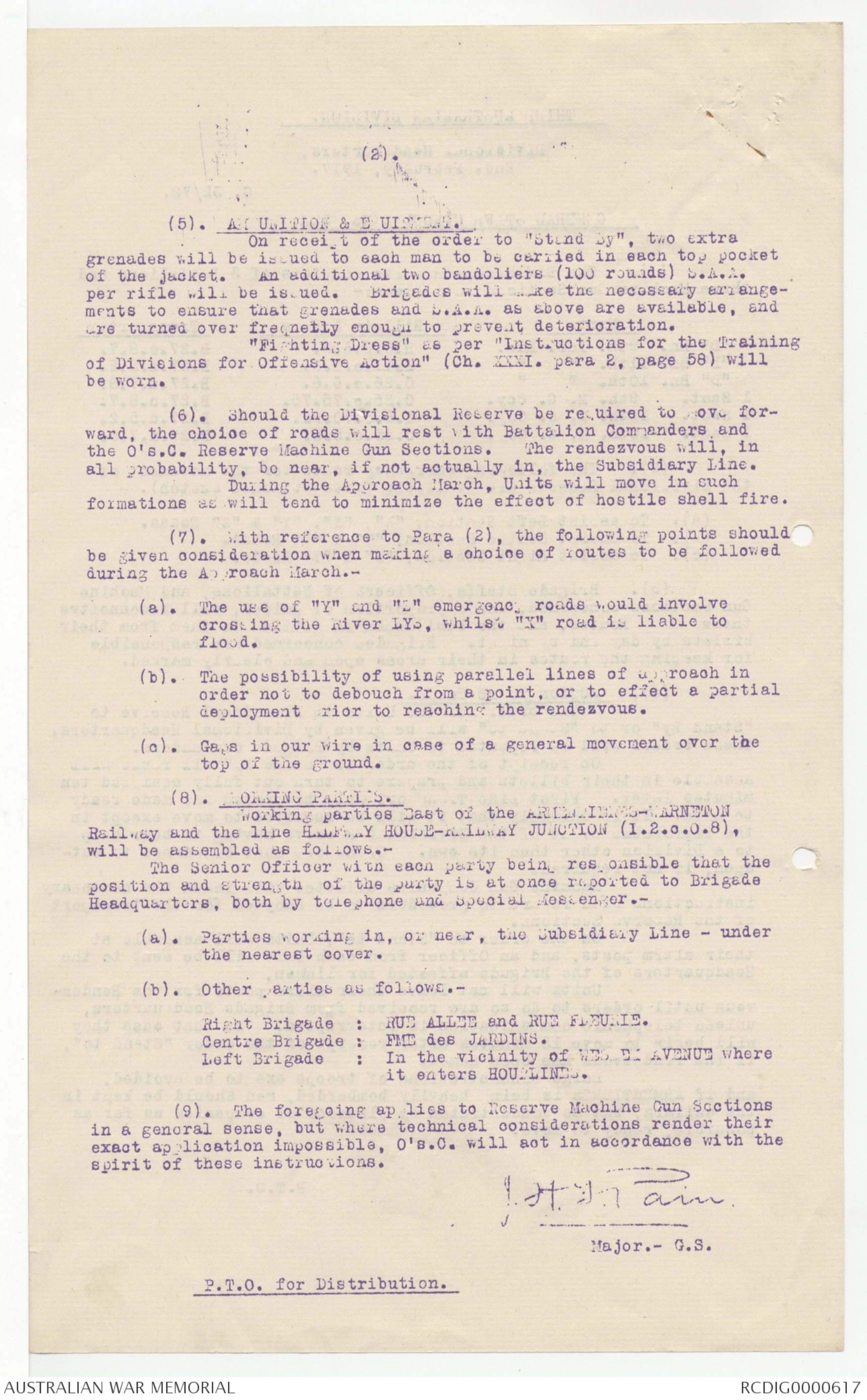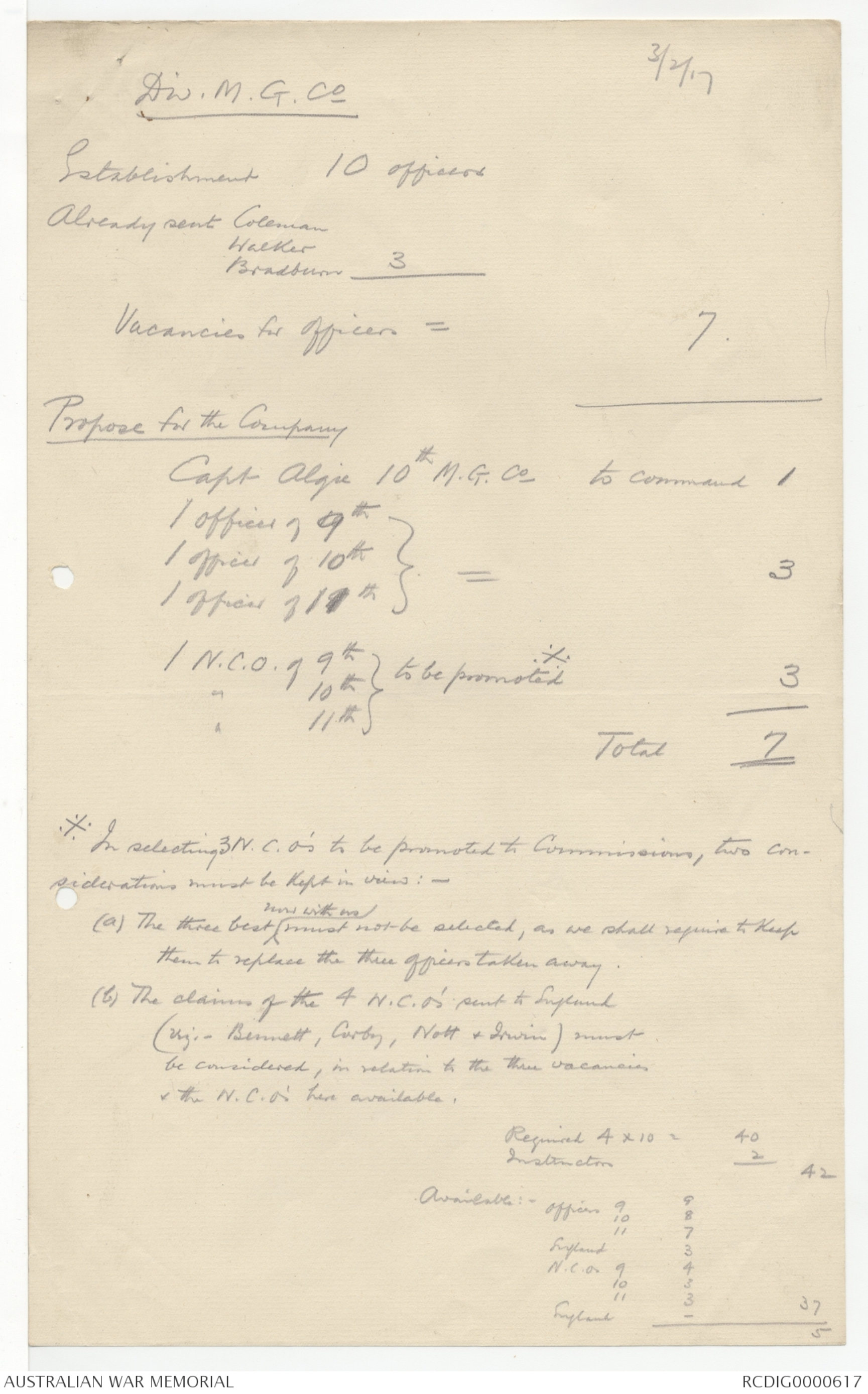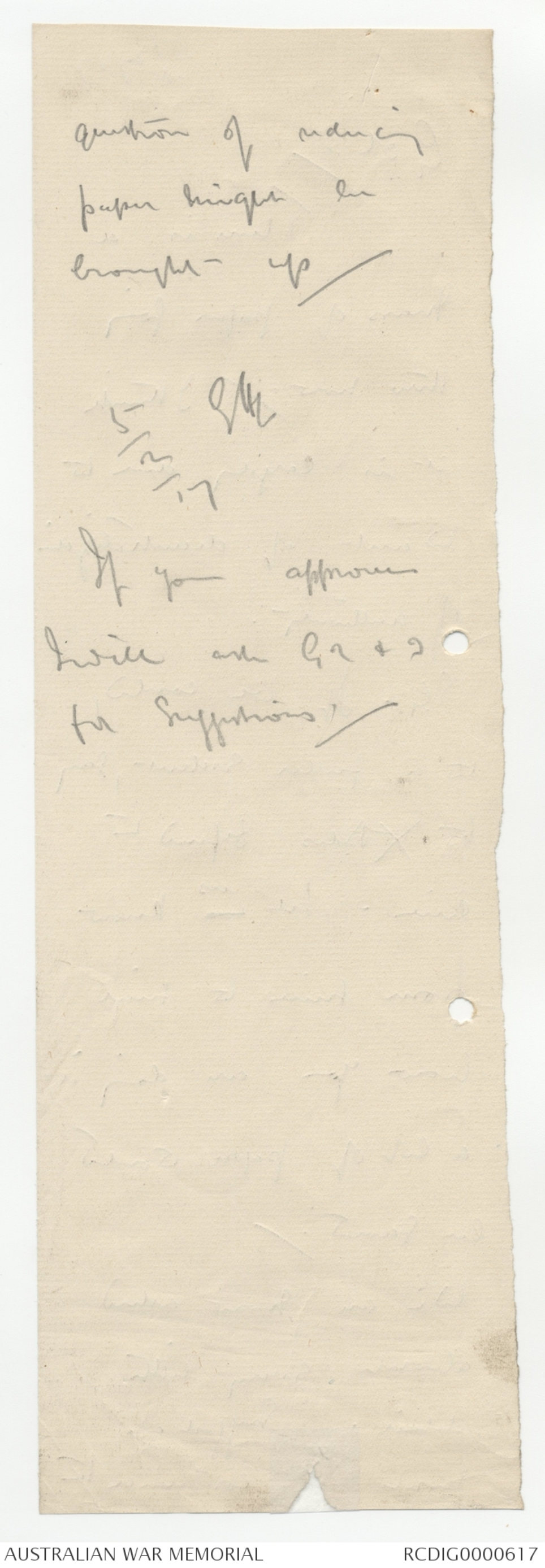Sir John Monash, Personal Files Book 14, 1 December 1916 - 10 February 1917, Part 17










From Dec. Army Lists 21-2-17
| Local & Temp Rank (contd.) | |||||||
| Active List | 23 | Babington 2655 | Maj-Gen | 18 Sept 14 | |||
| 7 | Watts 2655 | " " | 27 Sept 15 | ||||
| Divn. | 6 | Ross 2655 | " " | 15 Nov 15 | |||
| 57 | Broadwood Lt. Gen 2301 | R. of O. | NZ | Russell 2655 | " " | 27 Nov 15 | |
| Aust 3 | Monash 2655 | " " | 10 July 16 | ||||
| 61 | Mackenzie | Maj-Gen 129 | 16 Jul 10 | 20 | Smith 2655 | " " | 8 March 16 |
| 47 | Gorringe 130 | " " | 6 Sept 11 | Cav 1 | Mullens 2655 | " " | 25 Oct 15 |
| 50 | Wilkinson 131 | " " | 8 Aug 12 | 56 | Hull 2655 | " " | 6 Feb 16 |
| 58 | Fanshawe 131 | " " | 6 Oct 13 | 21 | Campbell 2655 | " " | 28 May 16 |
| 35 | Landon 132 | " " | 20 Oct 14 | Guards | Fielding 2655 | " " | 3 June 16 |
| 15 | M |
" " | 26 Oct 14 | 38 | Blackader 2655 | " x | 12 July 16 |
| 29 | De Lisle 137 | " " | 18 Feb 15 | 1 | Strickland 2655 | " x | 12 June 16 |
| 24 | Capper 137 | " " | 3 June 15 | 34 | Nicholson 2655 | " x | 25 July 16 |
| 33 | Penney 137 | " " | 3 June 15 | Cav 5 | Macandrew 2655 | " " | 7 May 16 |
| 48 | Fanshawe 138 | " " | 3 June 15 | 5 | Stephens 2655 | " " | 1 Ap. 16 |
| 49 | Perceval 138 | " " | 3 June 15 | Canad 4 | Watson 2655 | " " | 25 Ap 16 |
| 62 | Braithwaite 138 | " " | 3 June 15 | Canad. 1 | Currie 2655 | " " | 13 Sept 15 |
| 14 | Lambton 138 | " " | 3 June 15 | 30 | Shea 2656 | " " | 17 May 16 |
| 12 | Scott 139 | " " | 1 Jan 16 | 17 | Robertson 2656 | " x | 13 July 16 |
| 14 | Couper 139 | " " | 1 Jan 16 | 46 | Thwaites 2656 | " | 18 July 16 |
| 36 | Nugent 139 | " " | 1 Jan 16 | 19 | Bridges 2656 | " | 13 Dec 15 |
| 5 | Harper 140 | " " | 1 Jan 16 | Canad 3 | Lipsett 2656 | " | 16 June 16 |
| Aust 1 | Walker 140 | " " | 1 Jan 16 | 3 | Deverell 2656 | “ | 8 July 16 |
| 55 | Jendwine 140 | " " | 3 June 16 | ||||
| 9 | Lukin 2656 | Brig-Gen. | 1 July 12 | ||||
| Local, Temporary Rank | 8 | Heneker 2656a | x | 29 Oct 16 | |||
| 25 | Bainbridge 2654 | Maj-Gen | 2 June 16 | 37 | Williams 2657a | 5 June 16 | |
| 39 | Cuthbert 2654 | " x | 12 July 16 | Aust 2 | Smyth 2657b | 20 May 15 | |
| 16 | Hickie 2654 | " " | 5 Dec 15 | Aust 5 | Hobbs 2657c | 15 Aug 14 | |
| 41 | Lawford 2654 | " " | 13 Sept 15 | 32 | Barnes 2657c | 5 Apr 15 | |
| 40 | Ruggles-Brise 2654 | " " | 25 Sept 15 | Aust 4 | Holmes 2657c | 21 Aug 15. | |
| Cav. 3 | Vaughan 2654 | " " | 15 Oct 15 | 2 | Periera 2657f | 18 May 15 | |
| 31 | Wanless O'Gowan 2654 | " " | 24 Aug 15 | Cav 2 | Greenly 2657f | 14 Ap 15 | |
| 63 | Schute 2655 | " x | 17 Oct 16 | Cav 4 | Kennedy 2657f | 4 May 15 | |
| 18 | Lee 2655 | " " | 7 July 16 | 11 | Ritchie 2657f | 20 May 15 | |
| Canad 2 | Burstall 2650b | 29 Sept 14 | |||||
THIRD AUSTRALIAN DIVISION.
Divisional Headquarters,
2nd. February, 1917.
G.32/72.
GENERAL STAFF CIRCULAR No. 32A.
(1). The Divisional Reserve consists of 3 Battalions and
three Machine Gun Sections as follows:-
Unit. Billets & Hors. Transport.
"D" Bn. 9th Inf. Bde. H.6.b.6.3. B.27.c.8.7.
"D" Bn. 11th. " " I.11.a.2.5. B.27.d.5.2.
"D" Bn. 10th. " " C.26.c.6.6. B.27.d.7.8.
1 Sect. 9th. M. G. Coy. C.25.c.75.75 B.27.c.8.7.
1 Sect. 11th. M. G. Coy. I.9.c.70.95 B.27.d.5.2.
1 Sect 10th. M. G. Coy. C.25.c.5.5. B.27.d.7.8.
(2). The following emergency roads for the movement of
the Divisional Reserve are available (vide attached sketch). -
(a). To assist Left Section, "W", "X", "Y" & "Z" Roads.
(b). To assist Centre Section, "U" & "V" Roads.
(c). To assist Right Section, "S" & "T" Roads.
(3). Brigade Staffs, Officers of Battalion, and Machine
Gun Sections concerned, and a proportion of guides, will reconnoitre
these Routes, and the best means of getting to them from their
billets by day and by night. Brigades concerned are responsible
for keeping the routes in their areas open and clearly marked.
(4). ACTION TO BE TAKEN.
The order for the Units in Divisional Reserve to
"Stand By" or to "Stand to" will be given by Divisional Headquarters.
These orders will be repeated to Units by Brigade Commanders.
On receipt of the order to "Stand By" all ranks will
assemble in their billets and prepare to turn out fully equipped ten
minutes later. First Line Transport will be packed and made ready
to move. It is unlikely that it will be required to move except in
the improbable event of the Divisional Reserve having to bear help
to a Division other that its own. Transport must be warned to outspan,
if not required.
Machine Gun Companies affected will issue the necessary
instructions with regard to procedure to be adopted for the transport
of the Reserve Sections.
On the order to "Stand to", Units will assemble at
their alarm posts, and an Officer from each Unit will be sent to the
Headquarters of the Brigade affected for liaison.
Units will not leave their alarm posts for the Rendezvous
until orders to do so are received from Brigade Headquarters,
unless telephonic communication is interrupted. In that case they
will begin to move 15 minutes after receipt of the order "Stand to",
if the rendezvous has been named.
Large concentrations of troops are to be avoided,
and if ARMENTIERES is being heavily bombarded, men should be kept in
the cellars, but as concentrated by platoons or companies as far as
possible, ready to move.
P.T.O.
(2).
(5). ACQUISITION & EQUIPMENT.
On receipt of the order to "Stand by", two extra
grenades will be issued to each man to be carried in each top pocket
of the jacket. An additional two bandoliers (100 rounds) S.A.A.
per rifle will be issued. Brigades will take the necessary arrangements
to ensure that grenades and S.A.A. as above are available, and
are turned over frequently enough to prevent deterioration.
"Fighting Dress" as per "Instructions for the Training
of Divisions for Offensive Action" (Ch. XXXI. para 2, page 58) will
be worn.
(6). Should the Divisional Reserve be required to cover forward,
the choice of roads will rest with Battalion Commanders and
the O's.C. Reserve Machine Gun Sections. The rendezvous will, in
all probability, be near, if not actually in, the Subsidiary Line.
During the Approach March, Units will move in such
formations as will tend to minimize the effect of hostile shell fire.
(7). With reference to Para (2), the following points should
be given consideration when making a choice of routes to be followed
during the Approach March. -
(a). The use of "Y" and "Z" emergency roads would involve
crossing the River LYS, whilst "X" road is liable to
flood.
(b). The possibility of using parallel lines of approach in
order not to debouch from a point, or to effect a partial
deployment prior to reaching the rendezvous.
(c). Gaps in our wire in case of a general movement over the
top of the ground.
(8). WORKING PARTIES.
Working parties East of the ARMENTIERES-WARNETON
Railway and the line HALFWAY HOUSE-RAILWAY JUNCTION (1.2. c.0.8),
will be assembled as follows. -
The Senior Officer with each party being responsible that the
position and strength of the party is at once reported to Brigade
Headquarters, both by telephone and Special Messenger.-
(a). Parties working in, or near, the Subsidiary Line - under
the nearest cover.
(b). Other parties as follows.-
Right Brigade : RUE ALLEE and RUE FLEURIE.
Centre Brigade : FME des JARDINS.
Left Brigade : In the vicinity of WESSEX AVENUE where
it enters HOUPLINES.
(9). The foregoing applies to Reserve Machine Gun Sections
in a general sense, but where technical considerations render their
exact application impossible, O's.C. will act in accordance with the
spirit of these instructions.
J. H. F. Pain
Major.- G.S.
P.T.O. for Distribution.
3/2/17
Div. M. G. Co
Establishment 10 officers
Already sent Coleman
Walker
Bradburn 3
Vacancies for officers = 7.
Propose for the Company
Capt Algie 10th M.G.Co to command 1
1 officer of 9th }
1 officer of 10th } = 3
1 officer of 11th }
1 N.C.O. of 9th }
'' 10th } to be promoted※ 3
'' 11th } Total 7
※ In selecting 3 N.C.O's to be promoted to Commissions, two considerations
must be kept in view :-
(a) The three best ^now with us must not be selected, as we shall require to keep
them to replace the three officers taken away.
(b) The claims of the 4 N.C.O's sent to England
(viz:- Bennett, Corby, Nott & Irwin) must
be considered, in relation to the three vacancies
& the N.C.O's here available.
Required 4 x 10 = 40
Instruction 2
42
Available:-
officers 9 9
10 8
11 7
England 3
N.C.O's 9 4
10 3
11 3
England - 37
5
3/2/17
Present
9 11 9 2
10 12 9 3 -
11 9 8 1
England 3 9 -
35 35 6
To be nominated
No 9 Company Lt Webb (D)
'' T. Graham
No 10 Company Capt ^W. M. Algie (D)
Lt Chambers (D)
Q.M.S. ^W. H. Mathieson
No 11 Company Sgt. Seddon
Capt Lieut J. Kissane
Claims of N.C.O's already in England considered
Future Command of Co.
3/2/17
Resources.
No 9.
Officers present Capt. Carey }
Lt Whitehead (D) }
" Wedd (D) }
Lt Graham } 8
" Harris }
2/Lt Wood }
" Brown }
" Badgery }
" Harris }
No 10. Capt Ordish }
" Algie (D) }
Lt Mackey (D) }
" Chambers (D) } 8
" Wardell (D) }
" Brown }
" Tyzack }
" Trumble }
No 11 Capt. A.T. Patterson }
" Taylor }
" R.L. Bennett (D) }
Wells (D) } 6
Hughes } 22
Kissane }
No 9 1 Cpl. Garnett }
2 Cpl. Carson } 34
3 Sgt McNamara }
4 " Horden } 4 Cpl. Carson
No 10. 1 Q.M.S. ^W.H. Mathieson }
2 Sgt Smith } 4
3 " Hooks }
4 " Youlden }
No 11 1 Cpl. Watts }
2 Sgt. Stewart } 3
3 Sgt Seddon } ___
32
Officers in England 3
35
Places to be filled 42
7
THIRD AUSTRALIAN DIVISION.
Divisional Headquarters,
5th February, 1917.
G.O.C.
3rd Australian Division.
NOTES FROM TO-DAY'S LECTURE.
(1). 4,700 yds. of front to a Corps. Corps on
the Somme were, I believe, 4 or 5 Divisions strong. Say 4
Divisions, therefore 1,200 yds. to a Division. This is more
than we were told in June last just before 2nd Division started for
the Somme. The idea then was 1,000 yds. became 1,500 yds. had
been tried and found too big.
[*No
X corps
had
2 Div
in line*]
(2). 2 Brigades attack beside each other, 3rd
Brigade in reserve.
(3). Zero hour was time Artillery lifted from
enemy's front line.
(4). A lie position appears to have been adopted
by the Infantry, but this was only incidentally mentioned.
(5). No creeping barrage employed.
(6). Departure trench to be not more than 200 yds.
from enemy's front line. This, also, was only implied.
Cameron referred to difficulty of maintaining a
Force at far side of a broad NO MAN'S LAND. This is not much
a question of position of departure trench, which is a debatable
point, depending on whether attack is by day or night, but is
a question of Staff arrangements for joining up and having
communication trenches dug directly our first elements are across.
Cameron laid stress on not going in deep on a wide
front because one gets bitten off. This is a well established
fact.
RebBombardment of our a portion of the line brought the
Lecturer to the same conclusion as that enunciated by you at the
Bustard, but this afternoon they were not as explicit with regard
to the possible help from air-craft, and the action to be taken by
the Infantry and Artillery.
They laid down that one Heavy Howitzer, e.g. 6",
was required for every 50 yards of hostile trench, and one
18 pdr. for every 15 yards.
They emphasised the necessity of keeping gaps open
in wire, if necessary using 18 pdr. fire for this purpose.
Artillery lifted to a depth of 2,500 yards in 2 hrs.
40 minutes. This is quicker than the average. Lifts were arranged
by the clock. Had to be so in order to co-ordinate Artillery work.
All ^that the Divisional Commanders can have ^is a call on a few
batteries for working ^on their ^his own front. This is all laid down.
On the whole I was very disappointed with the Lecture.
Had hoped to learn a great deal. I therefore did not take notes,
and the foregoing are purely from memory. What notes I did make
were with reference to our big raid which I was thinking of at the
time, e.g., burying cable and keeping gaps open. The Lecturer
mentioned that cable burying had to be undertaken well ahead of
Zero day.
Lieut-Colonel.
JM
5/2/17
GHI
5/2/17
G.OC.
There is a
mass of paper going
thro now. / I think
it is largely due to
want of decentralization
of authority.
E.G. If we could,
to a fuller extent, say
to to Bdes defend the
lines. Let me us know
from time to time
how you are doing it,
a lot of paper would
be saved.
We are now asked
about every little
detail. Suggest at
next conference the
question of reducing
paper might be
brought up
GHI
5/2/17
If you approve
I will ask G2 & 2
for suggestions.
Headquarters,
Second Army.
6th February, 1917.
Dear Monash
The following are notes compiled for my information
by Harington after his weekly conferences with Commanding
Officers. Half the C.Os. in the Army have now been here.
They are not forwarded in any spirit of criticism. They are
points he has discussed from week to week and bring out
certain things that we are all equally anxious to improve and
I am sure you will be only too glad to have them and will see
that the younger members of the staff do all they can to
cultivate a more sympathetic mode of treatment of units in
cases where such is required.
I am sending a copy of this to all Corps and
Divisional Commanders.
Yours sincerely,
Herbert Plumer
[*G.O.C.
I would like to
speak you re this
7/2
GHI
Replied to
JM
8/2/17*]
 Deb Parkinson
Deb ParkinsonThis transcription item is now locked to you for editing. To release the lock either Save your changes or Cancel.
This lock will be automatically released after 60 minutes of inactivity.